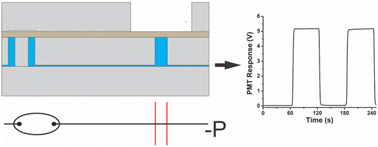Automated cellular stimulation with integrated pneumatic valves and fluidic capacitors†
Abstract
Microfluidic technologies have proven to be a reliable tool in profiling dynamic insulin secretion from islets of Langerhans. Most of these systems rely on external pressure sources to induce flow, leading to difficulties moving to more elaborate systems. To reduce complexity, a microfluidic system was developed that used a single vacuum source at the outlet to drive fluidic transport of immunoassay reagents and stimulation solutions throughout the device. A downside to this approach is the lack of flow control over the reagents delivered to the islet chamber. To address this challenge, 4-layer pneumatic valves were integrated into the perfusion lines to automate and control the delivery of stimulants; however, it was found that as the valves closed, spikes in the flow would lead to abnormal insulin secretion profiles. Fluidic capacitors were then incorporated after the valves and found to remove the spikes. The combination of the valves and capacitors resulted in automated collection of insulin secretion profiles from single murine islets that were similar to those previously reported in the literature. In the future, these integrated fluidic components may enable more complex channel designs to be used with a relatively simple flow control solution.

- This article is part of the themed collections: 150th Anniversary Collection: Microfluidics and Analyst HOT Articles 2023


 Please wait while we load your content...
Please wait while we load your content...